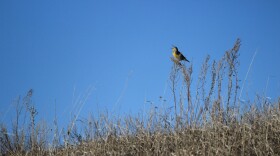The birds have been busy at our bird feeders this winter! The bulk of birds do not consume the seeds at the feeder -- Chickadees and nuthatches come in, get one sunflower seed, and quickly fly away. Blue jays fill up with several seeds before flying away. These birds are flying off to a safer place to open and/or consume the food, or perhaps cache it.
Caching, or hoarding, food is quite common among many animals, particularly those that live in areas with large seasonal changes in food availability and remain active during the winter months. Chickadees and nuthatches caching sunflower seeds in the crevices of bark on trees are good examples. Blue jays may cache several sunflower seeds in a particular location.
But there is a more to it than just stashing some food away. By gathering up and hiding food, these birds immediately get control of the food item against the competition, be it another member of the same species or of other species. And of course, the food items can then be stored for later consumption, perhaps when food is scarcer.
There are a couple approaches to caching or hoarding food: some animals collect food when it is abundant and store it in one (or a few) sites or larders. That approach is called larder-hoarding. Beehives and the middens of red squirrels are good examples. So are the acorn woodpeckers of the southwest that hammer holes into trees to store acorns. Hundreds of acorns may be stored into a single tree. But all that stored food in a single location needs to be defended from competitors or all could be lost.
Perhaps it could be better to store or hoard smaller amounts of food in many locations. That is called scatter-hoarding. Chickadees and nuthatches storing single sunflower seeds in the crevices of bark on several trees in their home range would be scatter-hoarding. Many caches with less food over a larger area is difficult to defend, but the loss of a few caches is not nearly as costly as if it contained a large trove of food.
No doubt some of the cached food will be found by competitors and some forgotten or just left. But caching works! So, as you watch the birds flitting in and out of the feeders this winter, consider that some of that bird food is being cached somewhere. If you are observant, you may even find a cache.





